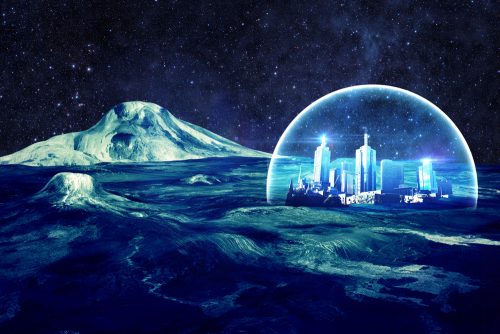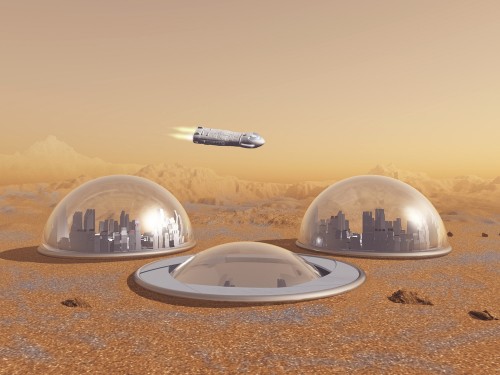If the human race wants to survive in the long run, we will probably have to colonize other planets. Whether this happens as a result of us making the Earth less habitable or the Earth reaching its natural end in its ability to support life, one day we will have to look for a new home

If the human race wants to survive in the long run, we will probably have to colonize other planets. Whether this happens as a result of us making the Earth less habitable or the Earth reaching its natural end in its ability to support life, one day we will have to look for a new home.
Hollywood films such as The Redeemer (save Mark Watney) or "Interstellar" provide us with a glimpse of what may await us. Mars is undoubtedly a favorite destination for habitation in our solar system, but there are thousands of planets orbiting other stars that could serve as a substitute for our Earth. So what are the technologies needed to make this task possible?
We already have one colony in space – the International Space Station, but it is 350 kilometers from Earth and relies on a constant supply of resources for a crew of six. Most of the technology developed for the International Space Station, such as radiation shielding, water and air circulation, solar energy absorption, and more, can certainly be transferred to other space colonies in the future. However, a colony on the surface of a planet or the moon will add a new set of challenges.
natural habitat
The first requirement for human habitation on another planet is the establishment of a habitat in an isolated environment capable of maintaining air pressure, the composition of the air (the amount of oxygen), and temperature, and protecting the inhabitants from radiation. Therefore, it is necessary to build a relatively large and heavy structure.
Lifting large and heavy objects into space is expensive and difficult work. Since the Apollo mission, which itself consisted of several modules that had to be separated in space, parts of the space stations assembled by astronauts have been sent.
Given the impressive progress we are seeing in the computerization of autonomously controlled systems, it is possible that the habitat will be able to assemble itself from the parts without human involvement. Today, even docking maneuvers at the station are performed completely automatically.
The alternative would be to bring a minimal "toolbox" from the earth and create the habitat using local resources. Specifically, XNUMXD printers could be used to turn minerals from the local soil into physical structures. In fact, we have already begun to examine the issue. A private company called Planetary Resources was able to XNUMXD print using raw material from a metal-rich asteroid fragment found at the site of a meteorite explosion on Earth. NASA installed a XNUMXD printer on the International Space Station to prove that such printers can be used in zero gravity. The intention is to produce spare parts for the space station in the future at the station itself.
Liquid lifeline

Once the built habitat is established, the colony will need a continuous supply of water, oxygen, energy and food to sustain its inhabitants, assuming the colony was not built on an Earth-like planet with such abundant resources. Water is fundamental to all life as we know it but can also be used to become fuel and shield against radiation.
An initial settlement will have to carry a certain amount of water and recycle any liquid waste. This has already been done in the International Space Station where not a single drop of liquid (washing, sweat, tears, or even urine) is wasted. But a colony on the ground of a solid body would also try to extract water from underground reservoirs of water or ice as there are on some asteroids.
Water is also a source of oxygen. In the space station, the oxygen is produced through the electrolysis process in which the hydrogen and oxygen are separated from the water. NASA is also working on developing techniques to regenerate oxygen from atmospheric byproducts, such as the carbon dioxide we exhale while breathing.
agriculture and energy
Energy production is probably the technological aspect of establishing a colony that we are best prepared for thanks to the photovoltaic solar panels. But depending on the location of the planet where the colony is located, we may need to improve this technology significantly. From the Earth's distance from the Sun, we can get up to 470 watts of electricity from every square meter of solar cells. This value is lower on the surface of Mars which is 50% more distant from the Sun compared to Earth and has an atmosphere that partially hides the Sun.
In fact, the Martian atmosphere causes the infamous periodic sandstorms because the sand limits the amount of light received by the plates and covers them. But we have already begun to face these problems in the planning of the all-terrain missions to Mars. For example the Spirit and Opportunity mission was supposed to last ninety days but Spirit survived for six years and Opportunity is still operating on the ground for over 12 years. It turns out that the winds blowing on Mars periodically clean the dust from the plates.
A colony obviously needs food. Without a Star Trek-style replicator, agriculture would be vital to food production. The crops can also be used to convert carbon dioxide in the air back into oxygen for breathing. Growing plants on Earth is relatively easy, because they have adapted to the environment for thousands of years, but growing fruits and vegetables in space or another planet is not so simple.
Temperature, pressure, humidity, carbon dioxide levels, soil composition and gravity - all of these affect the survival and growth of plants, of course the degree of influence is different for different species. At the same time, studies and experiments are being conducted to grow plants in a controlled environment that mimics the environment of a space colony. One possible solution that has already been proven on Earth has shown that it is possible to grow radishes, lettuce and green onions in space using hydroponic agriculture, where the plants are grown in a nutrient-enriched liquid without soil.
Climate change
The final requirement in a space colony will be maintaining a habitable climate. The composition of the atmosphere and climate of other celestial bodies is very different from that of Earth: there is no atmosphere on the Moon or on asteroids, and the atmosphere of Mars consists mainly of carbon dioxide. The surface temperature ranges from twenty degrees Celsius in the summer to minus 153 degrees during the winter at the Martian poles. However, the air pressure reaches about 0.6% of that of the Earth. In these extreme conditions the colonists will be limited to living inside the isolated habitats and any travel outside will only be possible using space suits.
In the long term, the prevailing idea is to change the planet's climate on a large scale - in a process known as earthing, similar to geoengineering solutions to combat climate change on Earth. This will require a huge effort but with similar techniques it will be possible to apply the technologies to other planets such as Mars.
Another possible way is bioengineering - converting carbon dioxide in the atmosphere to oxygen using bacteria or darkening the polar caps of Mars to reduce the amount of sunlight they radiate back into space and thus raise the surface temperature. Alternatively, it will be possible to place a large array of mirrors that will reflect the sun on specific areas such as the poles to cause a local increase in temperature. It is estimated that an increase in temperature using the technologies proposed in the paragraph, even if it is small, could lead to an increase in air pressure and allow the grounding of Mars

10 תגובות
First of all, the human race should be worthy of existing at all, put emphasis on the socioeconomic status of everyone, recognize the fact that the human race works as one and unified mechanism like the human body, after such a fundamental change occurs in which society cares for the well-being of all, it will be possible to talk about transitions to new worlds.
א
The dark matter is found in Bnei Brak
There is not going to be a galactic empire. As long as it is impossible to exceed the speed of light. The problem is also that man lives only 80-90 years. In the empires you imagine to deliver a message would take anywhere from thousands of years to hundreds of millions of years.
It would be easier to colonize all the oceans than Mars. And even in the worst scenarios of what humanity can do to the planet, it will still be more suitable for life than Mars (including a nuclear war not on us) Mars has no magnetic field and no ozone layer.
In my opinion, instead of looking for stars that are theoretically Earth-like
And we will never reach them. Instead, it is better to invest in understanding the universe and the rules of jurisprudence. Answer puzzles like the dark matter. It has a much better chance of contributing to humanity than searching a hundred thousand light years away for a star with a normal temperature. Manned missions to Mars should also be thoroughly examined if they are not done for populist reasons and the same result cannot be obtained in a cheaper way.
Dear L.A.!
The way they will probably move to distant planets will not be based on speeds close to the speed of light but on wormholes. So you can lay Einstein to rest...
She asked Mr. Schwartz how long Shana's crew was in space, that is, in the station
Don't put all your eggs in one basket.
In such a hurry to leave the earth... why not take care that it will be good here? Strict green laws, birth control all over the world including in developing countries, Arabia and India.
Without man, the earth can live for another 3 billion years at least, which is a lot... Homo sapiens has only existed for about 100,000 years....
At this rate, in 30,000 years there will be a Galactic Empire for the Milky Way.
When I was a child there was a photo album that we collected called The Wonderful World. There they also drew what it would be like to travel in space and settle in space in the future and more... and there was Poplarscience. in English and there. Today it turns out that the reality surpasses any imagination of the time..and it seems to me that this is also the case with the data we have today..the settlement will in my opinion be much more successful complex and sophisticated without value
You can talk about the settlement of Mars no more than that.
All the stars that have a chance of being earth-like (all of them are greater than the hidden over the visible) their distance is measured in less than hundreds and thousands of light years. So even if we build a spaceship that moves at a speed that is somewhat close to the speed of light (not something that science is close to) it will take thousands of years before they can even check if these stars are really suitable for life. The whole discussion about inhabiting planets of other stars is not possible until they prove that Einstein was wrong and it is possible to exceed the speed of light.